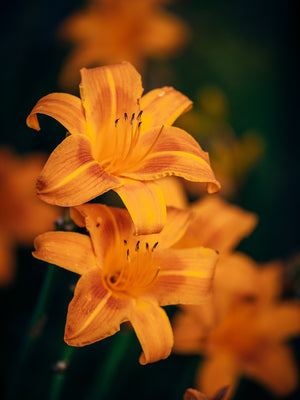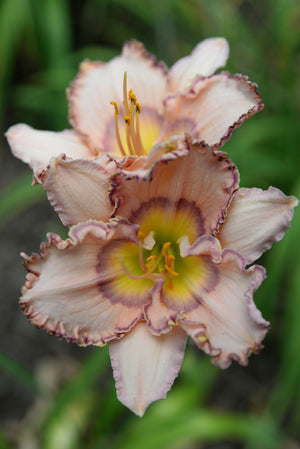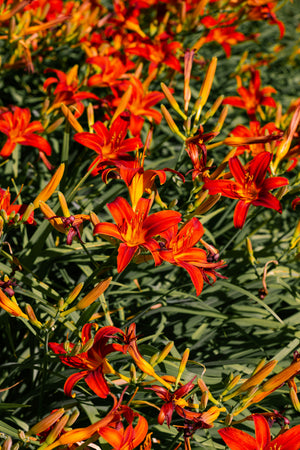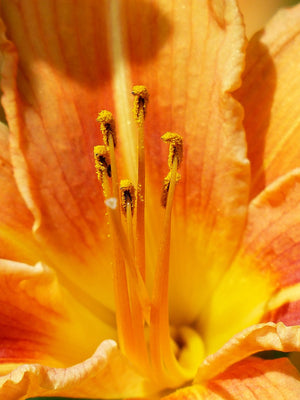The Hemerocallis Guide
Hemerocallis, commonly known as daylilies, are a favorite among gardeners for their vibrant blooms, remarkable resilience, and ease of care. With thousands of cultivars available, daylilies are as diverse as they are dependable, offering a wide palette of flower colors, shapes, and bloom times. These tough yet graceful perennials are perfect for borders, mass plantings, and pollinator gardens.

About
Hemerocallis belongs to the Asphodelaceae family and is native to parts of Asia. The name “daylily” refers to the ephemeral nature of each bloom, which typically lasts only one day. However, well-established clumps produce dozens of flower scapes, often blooming for several weeks through summer and sometimes again in late fall.
These perennials are grown for their trumpet-like flowers and sword-shaped foliage. Each clump gradually increases in size and flower production over the years. Notable cultivars include:
- Hemerocallis 'Chicago Apache' – Deep red blooms that stand out in the summer garden.
- Hemerocallis 'Pardon Me' – A compact, reblooming red variety ideal for small spaces or containers.
- Hemerocallis 'Hyperion' – A classic, fragrant yellow daylily with tall scapes.
- Hemerocallis 'Joan Senior' – Creamy white flowers that brighten shaded garden areas.
- Hemerocallis 'Barbara Mitchell' – Soft pink blooms that add elegance to mixed borders.
- Hemerocallis 'Happy Returns' – A bright yellow, reblooming variety known for its reliability.
- Hemerocallis fulva – The familiar orange daylily often seen naturalized along roadsides.
With newer introductions like 'Fours are Wild', 'Hungry Eyes', 'Raspberry Eclipse', and 'Star Struck', gardeners have nearly limitless design options.

PLANTING
Daylilies are incredibly adaptable and easy to establish in a wide range of garden settings:
- USDA Hardiness Zones: Most cultivars thrive in Zones 3–9.
- Soil: Well-drained, loamy soil enriched with organic matter is ideal. Though adaptable, overly wet soil can lead to rot.
- Sunlight: Full sun (6+ hours) promotes the best flowering. In hotter climates, some afternoon shade helps prevent bloom fade.
- Spacing: Space plants 18–24 inches apart to allow for mature clump size and airflow.
- Planting Time: Spring or early fall is ideal. Avoid planting during extreme heat or drought.
Dig a hole slightly larger than the root system, spread out the roots, and position the crown about 1 inch below soil level. Backfill, water deeply, and mulch to retain moisture.

CARE
Hemerocallis are low-maintenance but benefit from occasional grooming and division to maintain vigor:
- Watering: Water consistently during the first growing season. Once established, daylilies are moderately drought tolerant but bloom best with regular moisture.
- Fertilizing: Apply a balanced, slow-release fertilizer in spring. Avoid over-fertilizing, which can reduce flower production.
- Deadheading: Remove spent blooms to keep plants tidy and encourage repeat blooming in reblooming varieties.
- Cutting Back: After the first hard frost, cut foliage back to a few inches above ground to prepare for winter dormancy.
- Dividing: Divide clumps every 3–5 years in early spring or late summer when flowering declines. Lift the clump, gently separate fans, and replant.
Daylilies are relatively pest- and disease-resistant. Keep an eye out for aphids or daylily rust in humid conditions.

HOW TO USE
Daylilies are incredibly versatile in the landscape and mix well with a variety of plant types:
- Mass Plantings: Plant in large groups for a dramatic, low-maintenance display.
- Mixed Borders: Pair with echinacea, rudbeckia, salvia, or ornamental grasses for vibrant seasonal color.
- Slope Stabilization: Use on banks and hillsides where their dense root systems help control erosion.
- Pollinator Gardens: Hemerocallis attract bees and butterflies, especially fragrant and brightly colored types.
- Containers: Dwarf and compact varieties like 'Pardon Me' or 'Happy Returns' work well in pots.
Daylilies offer texture, color, and durability in settings where other perennials may struggle.

COMMON QUESTIONS
- How to grow Hemerocallis? Plant in full sun with well-drained soil, water regularly, and divide clumps every few years to maintain vigor.
- When to divide Hemerocallis? Divide in early spring or late summer, especially when clumps become overcrowded or bloom production declines.
- When to plant Hemerocallis? Plant in early spring or early fall for best root establishment.
- Are Hemerocallis perennials? Yes, they are hardy, long-lived perennials that return each year and often multiply.
- Are Hemerocallis poisonous to dogs? They are not considered highly toxic, but ingestion may cause mild gastrointestinal upset in some dogs.
- Are Hemerocallis poisonous to cats? Yes, all parts of the plant can be highly toxic to cats, potentially causing kidney failure.
- Where to plant Hemerocallis? Ideal spots include sunny borders, slopes, meadows, or foundation plantings with adequate sunlight and drainage.
- When to cut back Hemerocallis? Cut back foliage after a hard frost or when leaves yellow and die back naturally in fall.
Conclusion
Hemerocallis are among the most reliable and rewarding perennials in the garden. Their adaptability, low maintenance, and expansive range of colors make them ideal for gardeners of all skill levels. Whether you're looking to brighten a border, create mass plantings, or attract pollinators, daylilies deliver season after season. With just a little care and periodic division, they’ll provide decades of beauty.
The Hemerocallis Collection
Sold Out
Sold Out
Sold Out
Sold Out
Sold Out






